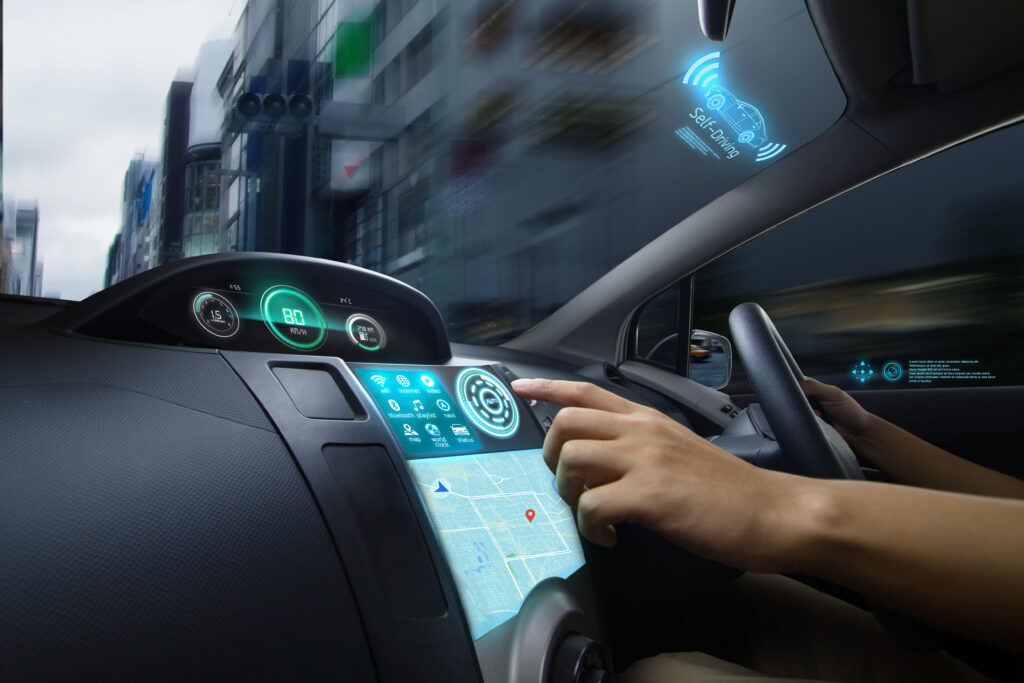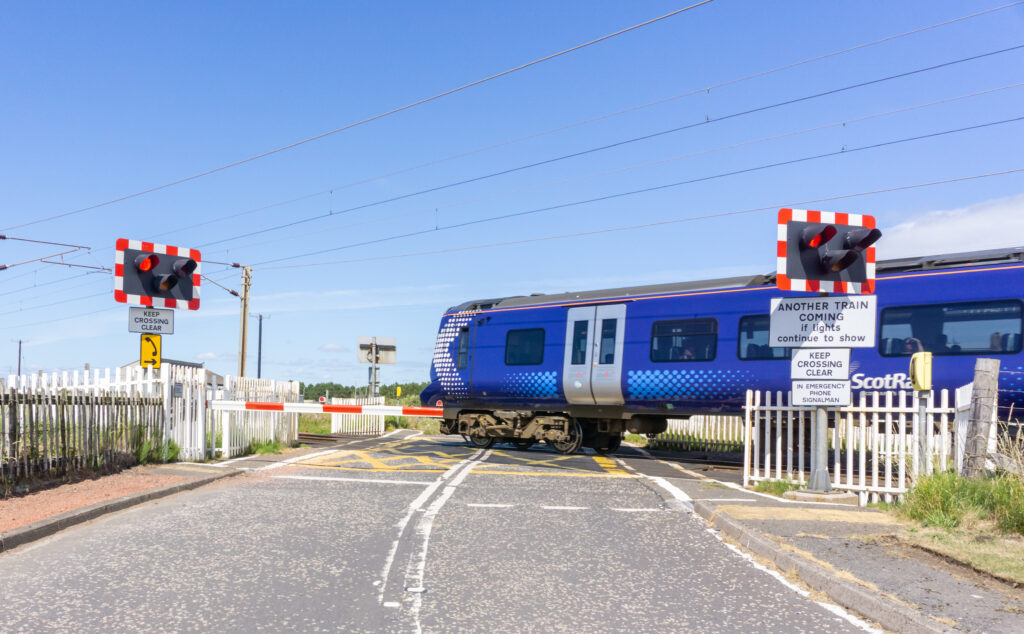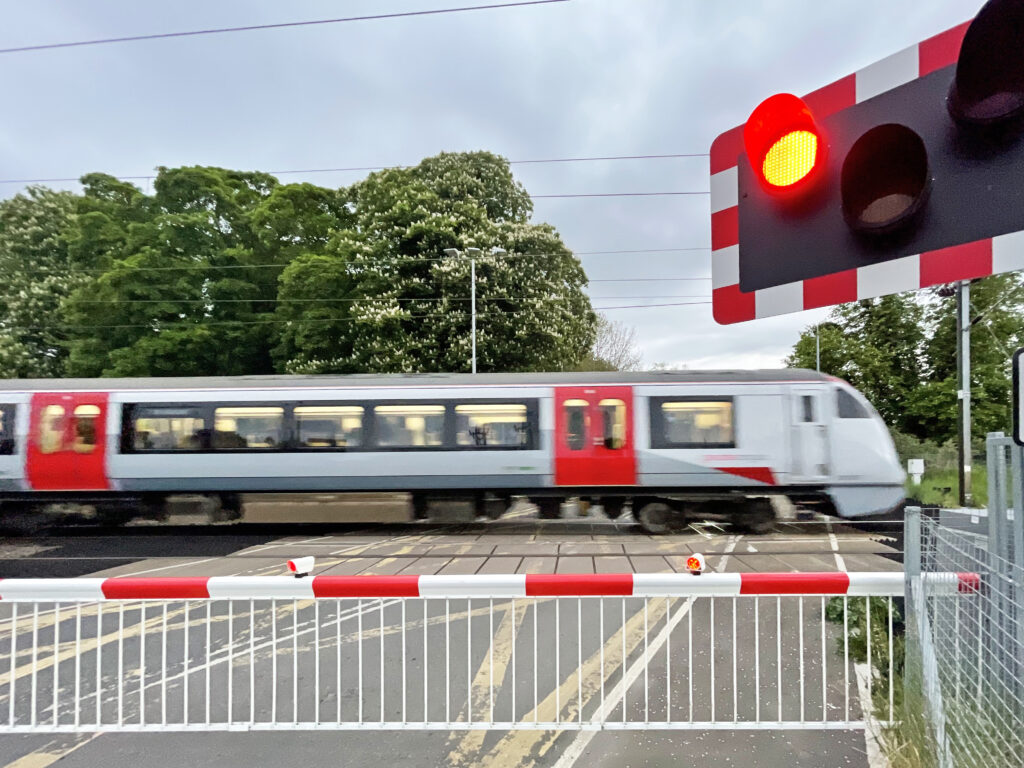Much has improved over the years to make road/rail level crossings safer, but collisions at level crossings are still a major cause of train incident risk. With level crossings being an open interface between the road and the railway there is increased potential for poor road user behaviour to affect train safety and place the level crossing user in danger. The risks, however, can be reduced by safe design and new engineering technology to prevent serious and fatal incidents. The latest initiative under development is using intelligent autonomous road vehicle technology to warn drivers and stop the vehicle safely on the approach to a closed level crossing.
There are approximately 6,000 level crossings in use on the mainline rail network in Britain and trains are now typically more frequent and travel at higher speeds than ever. At the same time more road traffic crosses the railway and road vehicles are becoming larger.
The safest level crossing is a closed one. However, this is not easy and can be very difficult and expensive to achieve. Even if budget and resources can be made available to eliminate a level crossing and provide a bridge or underpass, there is often not the available space to construct a safer alternative to a level crossing. Level crossings connect society, communities, and businesses, and people very often want their crossing to remain open, even when a case for closure on safety grounds can be made.
It only requires one person to object to a crossing closure for it to remain open, so where level crossing elimination is not possible the risks to users and the operational railway must be reduced so far as is reasonably practicable, and this is where new technology, such as intelligent autonomous road vehicles, could make a difference. This was the subject of a recent presentation to the IRSE by Hugh Rochford and Virgine Taillandier of SNCF.
They started by explaining that in France, despite extensive training and public awareness campaigns, more than 90% of level crossing incidents are caused by road drivers’ hazardous behaviour. They went on to describe a future alternative to improve level crossing safety by using innovative road vehicle technology through connected and Automated Vehicles (AVs). Instead of bringing more complexity to the railway systems, the objective is to address poor road driver’s behaviours, thus improving overall safety at level crossings.
Vehicle driver behaviour
The behaviour of a road driver traversing a level crossing with a road vehicle consists of three phases: anticipation of the situation, adaptation of the speed to the risk, and a final decision before entering the level crossing. For each phase, the behaviour depends on many factors, including the understanding of the immediate environment by the driver and leading in some cases to hazardous decisions.
Road vehicles are benefiting from a fast rate of technological improvement. For example, emergency radio links, including the fitment of digital car radios, have been mandatory in the EU since 2018. This allows localised emergency messages to be broadcast in case of an incident. Emergency radio links open new application developments, such as improving safety when using a level crossing. The concept is to alert the vehicle driver or vehicle direct of the status of the level crossing in adequate time to avoid a hazard. This has also been developed by the UIC – International union of railways with the DIGital Impacts (DIGIM) business processes programme through the ‘Traffic Message Channel’ for drivers, using Global Navigation Satellite System (GNSS) devices. DIGIM is a global cross-functional programme aimed at using new digital technologies to improve railway safety, operations, security, and make better use of existing data.
Vehicle to Everything (V2X) is a road vehicle technology being introduced to equip connected road vehicles. This system will allow safe communication in real-time with the environment, sharing between vehicles (V2V), roadside infrastructure (V2I) as well as to pedestrians (V2P) and cyclists via wireless consumer devices (V2D). V2X systems can be based on Wi-Fi and/or cellular (LTE) technology.
Around 30% of new vehicles sold in the EU, USA, China, and Japan are already provided with automated embedded functions known as Advanced Driver Assistance Systems (ADAS), which have been developed over the last decade. These ADAS systems consist of a list of assistive functions, such as adaptive cruise control, satellite navigation, active lane-keeping and centring, automated valet parking, traffic sign recognition and obstacle detection; up to the complete automation of driving and making the steering wheel optional. The vehicle is then categorised as an automated vehicle. It is expected that, by 2030, half of all road vehicles will be equipped worldwide with some ADAS functions. One of the ADAS functions is Traffic Sign Recognition, which enables a vehicle to recognise common road traffic signs and communicate the importance of the signs to the vehicle driver.

Promoting positive driving behaviour for level crossings
The concept is to simply connect the level crossing into an intelligent transport system, communicating directly with connected vehicles and to inform the driver and vehicle about the status of the level crossing ahead to allow them time to react appropriately. The objective is to improve level crossing safety without making extensive changes and the level crossing principle of operation would not be changed.
A control module would be fitted at the crossing, which monitors the status of the level crossing and a Road Side Unit (RSU) broadcasts level crossing messages to approaching road vehicles. A level crossing RSU has already been tested by C-Roads partners – a European initiative to develop a range of intelligent transport systems projects, along with technical and functional guidelines for future communication systems between vehicles and infrastructure deployed across Europe.
Messages are sent by hybrid communications (Wi-Fi and public mobile radio) for display on the vehicle road user Intelligent Transport Systems (ITS) system. These include: Danger! do not cross (in case of a level crossing out of service); Level crossing at xxx metres; Level crossing closed at xxx metres; Closed road; and Traffic restrictions in case of road limitations, e.g., limitation of speed, weight, height, width, or a specific ground profile (hump).
The integration of a cybersecurity layer in the ITS equipment allows the receiver to be assured that the sender is identified and trusted by adding a certificate of authenticity in accordance with ETSI standards. ETSI is the European standards organisation for telecoms.
Tests carried out in 2020 at Brec’h level crossing in France have validated the architecture including a security layer. Level crossing use cases are also being standardised and will be published in the next ETSI Standard TS 102 894 2 “Intelligent Transport Systems (ITS); Users and applications requirements; Part 2: Applications and facilities layer common data dictionary”.
Studies were carried out with a panel of 25 drivers. The study concluded that most of the drivers understood the messages and they wanted to be aware of the level of risk ahead.
However, the reaction could be split into two distinct categories. A majority of drivers anticipated the consequences by trusting the warning and taking appropriate measures (e.g., reducing speed even without seeing the danger), with a minority of drivers waiting for a conclusive and concurring warning to react (bell, red light, lowering barriers), and relying on their capacity to react quickly if needed.
The warning messages could be emphasised to the driver by an imperative ‘beep’ sound to increase his/her awareness. Even so, a quarter of the panel admitted that they would ‘zigzag’ through a malfunctioning level crossing despite the messages and the sounds! Other drivers said they would stop to think or make a U-turn to avoid the risk.
The study concluded that over 92% of drivers did react to the warning, enabling them to approach the level crossing safely by adapting their speed in good time and making sure enough time was left to react to the situation. Without the onboard warning system, only 30% of drivers took notice of the existing roadside warnings.
Automated Vehicles
Automated Vehicles (AV) are road vehicles equipped with sensors. The intention is that a computer will, in some situations, decide when to brake, when to accelerate, and when to steer, instead of the human driver. There are five levels of AV from Level 1 (road driver is assisted with functionality such as adaptive cruise control, keeping a safe distance with the vehicle in front, emergency brake assist, lane-keeping, lane-centring) through to Level 5 (a driver is not necessary; the vehicle is a ‘total’ Autonomous Vehicle).

AVs are therefore expected to react safely before a level crossing, which means the vehicle onboard system will control the vehicle if the risk is relevant and will request the driver to drive manually if the vehicle onboard sensors are not able to guarantee safe control.
As the Level increases from 1 to 5, more human responsibility is transferred to the vehicle system and sensors are used to understand the environment. The sensors will consist of devices such as, digital maps, V2X connectivity, Global Navigation Satellite System (GNSS) receivers, lidar, cameras, and telematics.
However, the high probability of a fatality in the case of a collision with a train currently discourages most vehicle manufacturers from including level crossings in the scope of their automated vehicles. It is just too risky for them. Therefore, SNCF have collaborated with vehicle supplier VALEO to address this with the HERMES project. HERMES aims to develop a closer and more effective communication between researchers working in the field of transport technologies in the EU, and their counterparts around the world, by exchanging information and developing long-term collaboration.
Most level crossing incidents are caused by voluntary or involuntary violation of traffic rules, human driving mistakes, or distractions, and it was identified that automated/ autonomous vehicles could play a positive role in addressing some of these causes.
Approaching a level crossing with an AV with interfaced brakes
In the case of an Automated Vehicle with interfaced brakes approaching a level crossing, the Automated Vehicle (Level 3 or 4) can cross the level crossing without any driver’s intervention, with ‘hands off’ the steering wheel and the vehicle starting and stopping itself automatically.
In 2021, at an automatic level crossing in Brittany (France) tests were carried out and met the expected performance in terms of functionality, security, and road safety. In the case of a message about an out of order level crossing, the vehicle did stop before the level crossing, or change its route.
The target scenarios could be fulfilled by the automated vehicle with the expected performance in terms of functionality and safety, and without hazardous behaviour. In particular, the assistance provided by the level crossing via the V2X communication link turned out to be especially useful.
Challenges
There are many issues and challenges to be addressed with AVs and level crossings. Each railway around the world has a different level crossing configurations (e.g., fixed or flashing red lights, traffic signs – red and white barriers in Great Britain/ France/ Germany, but yellow and red in Norway/Sweden) or their operating modes (various flashing frequency for the traffic lights, various closing time). Sensors and algorithms therefore may have to be adapted to accommodate all the different railway requirements and this will increase the costs and complexity of the AV systems. And who takes responsibility if a ‘connected’ level crossing is unable to prevent a collision with an AV and a train?
Cybersecurity is another issue and, with a machine taking over the human decision-making role, a complete safety analysis including ethics would be required to manage the risks to an acceptable level.
Would all rail infrastructure managers be able to support intelligent automated road vehicle operations? Depending on the country and railway, the interest of infrastructure/level crossing managers may differ (due to the cost/benefit ratio required). Would there be an economy of scale for the AV road vehicle manufacturer? Would the AV manufacturer be willing to take on the risk to their business if something went wrong?
With the different legal frameworks that exist around the world, a way would have to be found for providing the right level of assistance to the AV manufacturer without causing an unacceptable transfer of responsibility to the infrastructure manager, while still providing the right support from the railways with an appropriate level of quality at an affordable cost for the AV manufacturer. AV manufacturers are unlikely to want to develop for all the different level crossing systems around the world.
Currently, it is believed there is no legal position on responsibility-sharing when using a connected level crossing to provide critical information to an AV. However, new vehicles will increasingly be monitored with mandatory recording systems (black box) as newly manufactured vehicles are now in Europe.
Most of the costs for intelligent autonomous road vehicles and level crossings are with the vehicle manufacturer, and developing algorithms and sensors is very expensive. Maintenance of the vehicle is usually the vehicle owner’s responsibility. The connected level crossing will need a transmission link to communicate with the vehicle, but who pays? Installation and maintenance costs will also have to be considered by the infrastructure manager for the required crossing equipment throughout the lifetime of the level crossing.
Benefits and future work
Hugh and Virgine explained that the first benefit of AVs and level crossings is societal by protecting human life. In France they estimate that for automated vehicles and level crossings, the return on investment could be an 80% to 90% reduction in level crossing incidents.
The Society of Automotive Engineers describes six levels of road driving automation, similar to the way railways describe the four train Grades of Automation (GoA).
Level 0 – no automation.
Level 1 – hands-on/shared control. The road driver acts as in Level 0 and is assisted with some functionality (adaptive cruise control keeping a safe distance with the vehicle in front, or emergency brake assist, lane-keeping, lane-centring).
Level 2 – hands off the wheel, but the road driver supervises the driving. This is as Level 0 and is assisted over multiple functionalities, leading to highway (lane keeping) assistance, automated obstacle avoidance, and automated parking.
Level 3 – from this level the AV computer can drive the vehicle on the highway, but the road driver is asked to take over in any unknown environment situation.
Level 4 – the AV can drive the vehicle most of the time and the road driver is asked to take control in very specific situations. The AV can also park the vehicle automatically.
Level 5 – the driver is not necessary; the vehicle is a ‘total’ Autonomous Vehicle. A Level 5 AV can face all risks and decides without the supervision of a human.



Conclusion
The use of intelligent AVs to prevent level crossing incidents is an interesting one. There are those who may dismiss AVs and understandably will always want a driver to be in control of a road vehicle. However, there is already much of the required technology and standards in place to protect level crossings using AVs, and many road vehicles are already equipped for AV Level 1 and Level 2. There are road vehicles which already alert drivers of road hazards ahead and automatically commence the braking of the vehicle. Concerns were raised when road vehicle safety was improved with the fitment of seatbelts and wearing them was subsequently made mandatory, but no one questions this now.
Railway level crossing safety has improved over the years with the adoption of new technology; such as the introduction of interlockings, approaching locking of gates using track circuits, LED signage, CCTV, and obstacle detection. The investment in road vehicle technology is huge and developing fast, and the rail industry cannot afford to ignore the benefits of intelligent autonomous road vehicles and level crossings.
There will be issues to be overcome, such as the legal responsibility when things go wrong and who pays for what, but many of the safety improvements mentioned have followed very serious incidents with loss of life and subsequent inquiry recommendations. We can only trust that the benefits of AVs and the prevention of level crossing incidents does not have to wait till another very serious incident and inquiry.

Image credits: iStockphoto.com

